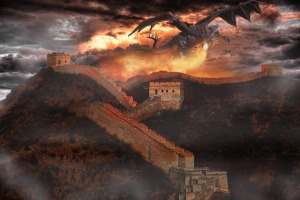I’ve been thinking about all the ruins on the southern continent, with the city of Avitium in the north. (I also discovered another set of ruins in the area on the randomly generated map.) In an earlier post, I mused that the ruins could have been the result of an incursion by dragons and/or giants. Given that in the mythology of Tyria dragons and giants were banished to opposite sides of the world, I think I would prefer the dragons to have been banished to the mountains on the two southern continents and the icy south pole. So it was dragons that resulted in the destruction of a once might empire, and thus we have our first big historical event:
The Dragon Scourge
The once great empire of Pallantium stretched across the southern continent, with its greatest cities in the north and east of the kingdom, where they flourished as they traded with the other peoples and kingdoms of Tyria. Ruled by a council of citizens, referred to as the Demiarchs, the empire prospered. While the great forests were tended by elves, and the mountain quarries by dwarves, all races mingled in the cities and held positions of leadership. Each of the cities boasted its own Greenstone colossus, with the capital at Avitium boasting two within its walls: The Great Wolf and the Kingstone. The latter is actually a huge building with three 100-foot statues standing in front. The center statue is a bearded man wearing a crown, and holding a greatsword, point down. To his right is a woman wearing robes and crowned in ivy, holding an unfurled scroll. On the king’s left is a figure of indeterminate gender, a star on their brow, and holding a sphere between their hands. All three statues stand tall and slender, with their arms close against their bodies, giving them the appearance of ornately carved columns. Arches connect the outer two statutes to the building itself, and the only entrance to the building is directly behind the king figure.
The Demiarchs ruled peacefully, and as the population grew, so did the desire for goods, food, and stone for building. It was this last that pushed the quarries deeper into the mountains, and when the dwarves found what they thought was a vein of Greenstone, the Demiarchs began planning: Perhaps there was a way to mine the divine material. They pushed their wizards to research ways of extracting and forming Greenstone and the miners to dig even deeper to uncover more of it. The vein turned out to be a long buried monolith, an arch of immense proportions, with a huge wheel inscribed within. Unfortunately, the monolith was also a lock, and when uncovered, it released the seals that kept scores of dragons banished from the surface of Tyria.
The dragons quickly spread out across the continent, and the people of Pallantium were unprepared for the onslaught. All the cities fell to the beasts, except for Avitium, where the army was the largest, and the Kingstone provided shelter to many and became known as the Unassailable Fortress. Eventually, many of the dragons fell to the swords and spells of the Pallanti army and mercenary adventurers, but some remained, making their lairs in the mines and in the ruined cities. The ruins not occupied by the dragons became home to other fearsome creatures. The dragons had killed many people, razed many towns, and destroyed huge tracts of farmland. In a matter of weeks, the great empire of Pallantium was reduced to the smoldering but still defended city of Avitium.
That was 500 years ago. The clerics of the city provided the initial comfort and aid to the citizens, who quickly elected them as Demiarchs. Since then, the temples have ruled the city from the Unassailable Fortress. In the last hundred years, the Demiarchs have begun seeing the city again grow as the generations forget the terror of the dragons. A new fortress was built at the city of Medieatum, and was rededicated as Castrum Nova. Time will tell if the newly expanding empire will attain the greatness it once held.

